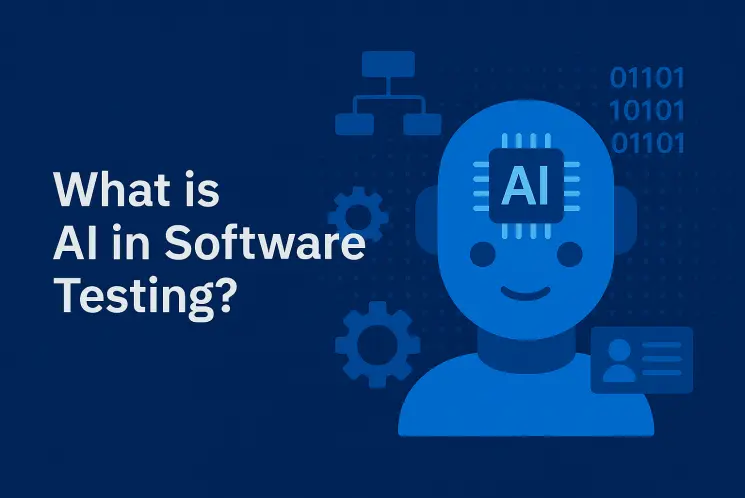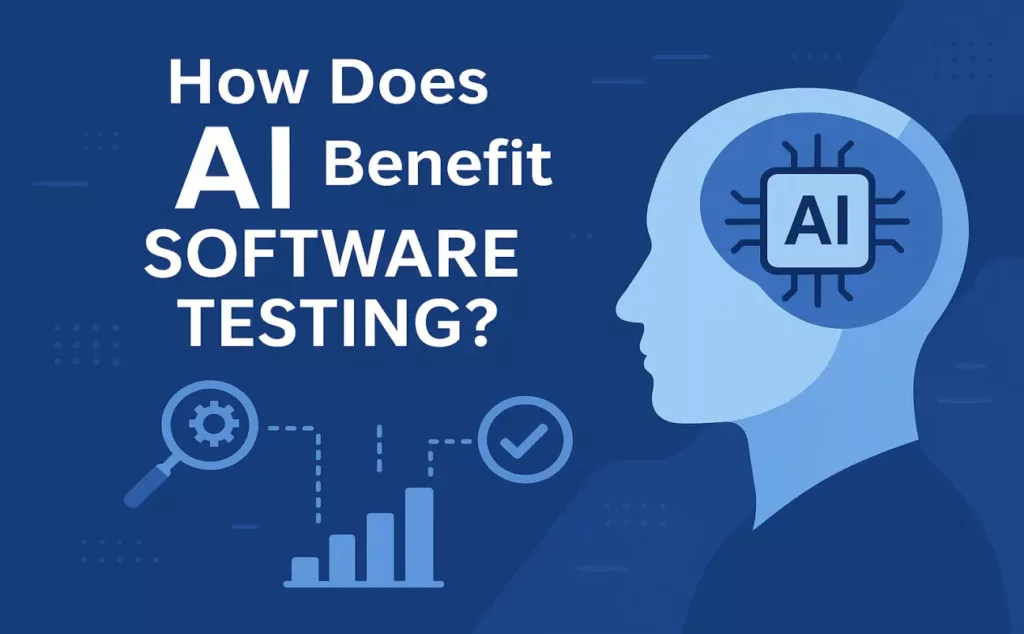Is your software testing process ready for what’s next? In 2025, AI is the key to making quality assurance faster, smarter, and more accurate than ever before. In this month V-Techhub, we’re exploring exactly how.
In recent years, Artificial Intelligence (AI) has significantly transformed various industries, including software development and quality assurance (QA). The integration of AI into software testing processes has led to the evolution of automated testing, improving both efficiency and accuracy in identifying defects. This article explores how AI is being used in software testing and the potential benefits it offers.
Table of Contents
1. What is AI in Software Testing?

AI-driven software testing uses machine learning algorithms and intelligent tools to simulate human interactions, enabling the system to autonomously identify issues, test different scenarios, and enhance the overall quality of software. By analyzing historical data and continuously learning from previous test cases, AI tools can generate new test cases, predict future bugs, and even optimize the testing process.
2. How Does AI Benefit Software Testing?

AI in software testing provides several key benefits:
- Faster Test Execution: AI tools can execute tests much faster than manual processes, significantly reducing time spent on repetitive tasks.
- Increased Test Coverage: AI allows for extensive test coverage by exploring different configurations, environments, and paths that may have been overlooked in traditional testing.
- Predictive Analysis: AI can predict the likelihood of defects occurring based on historical data and previous trends, helping testers focus on high-risk areas.
- Automation of Repetitive Tasks: Routine and repetitive tasks, such as regression testing and data-driven testing, can be automated, allowing human testers to focus on more complex and creative tasks.
- Enhanced Accuracy: AI reduces the likelihood of human error, ensuring that test results are more accurate and reliable.
3. Key AI Applications in Software Testing
a. Test Case Generation
AI can analyze the code, requirements, and previous tests to automatically generate new test cases. This helps testers explore potential weaknesses in the software that may not have been considered before. Tools like EvoSuite utilize evolutionary algorithms to generate unit tests for Java applications, identifying potential bugs through automated test creation. Additionally, model-based testing approaches leverage models representing system behaviors to derive test cases, improving test coverage and efficiency.
b. Intelligent Test Execution and Maintenance
AI optimizes test execution by dynamically adjusting to application changes. Platforms such as mabl employ machine learning models to adapt test scripts automatically when the application undergoes modifications, reducing maintenance efforts by up to 85%. This adaptability ensures that the testing process remains efficient and effective amidst continuous development cycles.
c. Predictive Defect Detection
Machine learning algorithms analyze historical defect data to predict potential failure points in software applications. By identifying patterns and trends, AI can forecast areas with a high likelihood of defects, allowing QA teams to focus testing efforts on these critical components, thereby improving overall software quality.
d. Visual and UI Testing with AI
AI-powered tools like Applitools Eyes utilize computer vision to perform visual testing, comparing application screens across different environments to ensure consistency and detect visual anomalies. This approach enhances user experience by identifying UI discrepancies that might be overlooked during manual testing.
e. Differential Testing and Model-Based Strategies
Differential testing involves comparing the behavior of multiple software implementations to identify discrepancies. AI facilitates this process by generating diverse test inputs and analyzing outputs across different systems, enhancing the detection of inconsistencies and improving software reliability.
4. AI Testing Workflow Diagram

The typical AI testing workflow consists of the following stages:
- Data Collection and Analysis: The AI system collects data from historical tests, code, and user interactions.
- Test Case Generation: The system uses machine learning to create new test cases based on patterns detected in the collected data.
- Test Execution: AI runs the tests, adapting the approach based on real-time data analysis.
- Defect Identification: The AI system flags potential defects, categorizing them based on severity and risk.
- Continuous Learning: The AI system improves over time by learning from new test data and adjusting its processes for future tests.
5. Technical Insights and References
- AI-Driven Test Case Generation: AI tools like EvoSuite and Model-Based Testing improve the generation of test cases by analyzing code and system behaviors to predict potential weaknesses. These approaches increase the test coverage and efficiency, allowing for the identification of defects that might otherwise be overlooked.
- Intelligent Test Execution and Maintenance: Platforms like mabl automate the adaptation of test scripts, reducing the maintenance load by analyzing application changes and modifying tests in real time, making the testing process more adaptable to frequent updates.
- Predictive Defect Detection: AI’s ability to analyze historical data for defect patterns provides valuable insights into areas with high-risk vulnerabilities, allowing teams to prioritize testing efforts more effectively.
- Visual Testing: AI-powered visual testing tools such as Applitools Eyes use computer vision algorithms to compare and detect discrepancies in user interfaces, ensuring consistent visual quality across platforms.
References:
- EvoSuite: Automated Unit Test Generation for Java Applications. Link
- Model-Based Testing: Approaches and Applications. Link
- mabl: AI-Powered Test Automation Platform. Link
- Machine Learning in Software Testing: Applications and Strategies. Link
- Applitools Eyes: Visual AI Testing for Web and Mobile Applications. Link
- Differential Testing: Techniques and Tools. Link